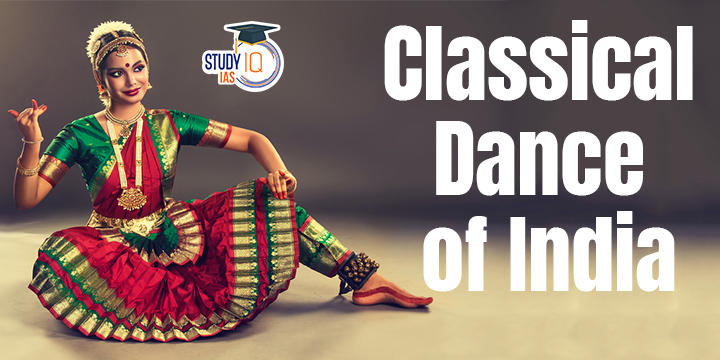Table of Contents
Classical Dances of India
Classical Dances of India: Technicalities and rigid guidelines are a big part of classical dances. The technical underpinnings of all traditional dance forms are laid down in Acharya Nandikeshawara’s “Abhinaya Darpan,” Sharangdev’s “Sangeeth Ratnakar,” and the Natya Shastra (which includes their body movements, rasa, bhava etc). According to India’s Ministry of Culture, there are nine recognised classical dances. Dance is first mentioned in a well-known work in Bharat Muni’s book Natya Shastra. Folk and classical dances are just two of the many types of dance practised in India.
List of Classical Dances of India
Here is the List of Classical Dances of India:
| S.No |
Name of Classical Dance |
Place of Classical Dance |
| 1 | Bharatanatyam | Tamil Nadu |
| 2 | Kathak | Northern India |
| 3 | Kathakali | Kerala |
| 4 | Kuchipudi | Andhra Pradesh |
| 5 | Manipuri | Manipur |
| 6 | Mohiniyattam | Kerala |
| 7 | Odissi | Odisha |
| 8 | Sattriya | Assam |
Classical Dances of India with States
|
Dance Forms |
Location |
Significance |
| Bharatanatyam | Tamil Nadu |
|
| Kuchipudi | Andhra Pradesh |
|
| Kathakali | Kerala |
|
| Mohiniyattam | Kerala |
|
| Odissi | Odisha |
|
| Manipuri | Manipur |
|
| Sattriya | Assam |
|
| Kathak | Uttar Pradesh |
|
List of Prime Minister of India
Famous Classical Dancer in India
|
Dancer |
Dance |
| Rukmini Devi Arundale
|
Bharatnatyam
|
| Pandit Birju Maharaj
|
Kathak
|
| Uday Shankar
|
Fusion
|
| Kelucharan Mohapatra
|
Odissi
|
| Guru Bipin Singh
|
Manipuri
|
| Guru Vempati Chinna Satyam
|
Kuchipudi
|
| Padma Subrahmanyam
|
Bharatnatyam
|
| Shovana Narayan | Kathak
|
Classical Dances of India Components
From the musical play or sangeet-nataka performed from the 12th to the 19th century, contemporary classical dance styles have developed. Tandava (movement and rhythm) and Lasya are the two fundamental elements of Indian classical dance (grace, bhava & rasa). The three primary elements are-
- Natya (the dramatic element of the dance i.e. the imitation of characters)
- The Nritta (the dance movements in their basic form)
- Nritya (expressional component i.e. mudras or gestures)
These are the nine rasas: love, heroism, pathos, humour, anger, fear, disgust, wonder, and peace. The Natya Shastra, authored by Bharat Muni, is the primary work used by Indian aestheticians to define the features of dance.
Classical Dances of India UPSC
The Ministry of Culture also recognises Chhau Dance as a classical dance of India, bringing the total number of classical dances in India to nine. Sangeet Natak Academy (India’s National Academy) only recognises eight of these dances.
Several crucial aspects of chhau dance are as follows:
- The Chhau Dance has meaning because to the name “Chaya.” Chaya is Hebrew for shadow
- Chhau dance is identified as a mask dance.
- An essential component of Chhau Dance is its energetic martial art moves.
- Chhau Dance uses a number of narrations, including Serpent Dance and Peacock Dance.
- The Chhau Dance comes in three varieties: The Chhau dance known as Saraikella is well-known in Jharkhand, as is the Chhau dance known as Mayurbhanj in Odisha, and the Chhau dance known as Purulia in West Bengal.
- Masks are not used in Mayurbhanj Chhau Dance.
- The Chhau Dance was added to the Representative List of Intangible Cultural Heritage of Humanity maintained by UNESCO.
Classical Dances of India FAQs
Q) What are the 8 main classical dances of India?
Ans. Bharatanatyam, Kathak, Kuchipudi, Odissi, Kathakali, Sattriya, Manipuri, and Mohiniyattam are the eight dance forms that the Sangeet Natak Academy acknowledges. Chhau, Yakshagana, and Bhagavata Mela have also been added to the list by scholars like Drid Williams.
Q) What are the 8 classical dances of India with states?
Ans. 8 classical dances of India are:
- Tamil Nadu: Bharatanatyam
- Northern India: Kathak
- Kerala: Kathakali
- Andhrapradesh: Kuchipudi
- Manipur: Manipuri
- Kerala: Mohiniyattam
- Odissi: Odisha
- Sattriya: Assam
Q) How many classical dances are in India?
Ans. There are eight classical dances in India
Q) What are the six classical dance of India?
Ans. Six classical dance of India are:
- Bharatanatyam
- Kathakali
- Kathak
- Manipuri
- Kuchipudi
- Odissi
Q) Which classical dance is best?
Ans. The best classical dance, commonly referred to as the “mother of all other classical dance styles,” is known as Bharatanatyam. It is also one of the oldest dance forms in India, having descended from Tamil Nadu’s temple dancers. Expressions, music, beat, and rhythm are all combined in the dance in its purest form.
Major Incidents in Indian History
- Quit India Movement
- Chauri Chaura Incident
- Jallianwala Bagh Massacre
- Green Revolution in India
- Non-Cooperation Movement
Famous Personalities Biography
| Mangal Pandey |
Maharana Pratap |
Rabindranath Tagore |
Bhagat Singh |
Jyotiba Phule |
Satyendra Nath Bose |
Raja Ram Mohan Roy |
Subhash Chandra Bose |





















 WhatsApp
WhatsApp